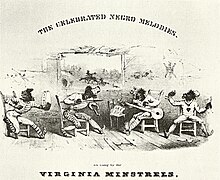User:Spencerb4king/Jazz practice page
Origins

By 1808 the Atlantic slave trade had brought almost half a million Africans to the United States. The slaves largely came from West Africa and brought strong tribal musical traditions with them.[1] Lavish festivals featuring African dances to drums were organized on Sundays at Place Congo, or Congo Square, in New Orleans until 1843, as were similar gatherings in New England and New York. African music was largely functional, for work or ritual, and included work songs and field hollers. The African tradition made use of a single-line melody and call-and-response pattern, but without the European concept of harmony. Rhythms reflected African speech patterns, and the African use of pentatonic scales led to blue notes in blues and jazz.[2]

In the early 19th century an increasing number of black musicians learned to play European instruments, particularly the
Notes
- ^ Cooke 1999, pp. 7–9
- ^ Cooke 1999, pp. 11–14
- ^ Cooke 1999, pp. 14–17, 27–28
- ^ Cooke 1999, p. 18
References
- Cooke, Mervyn (1999). Jazz. London: Thames and Hudson. ISBN 0-500-20318-0..
- ISBN 0-289-79827-2..
